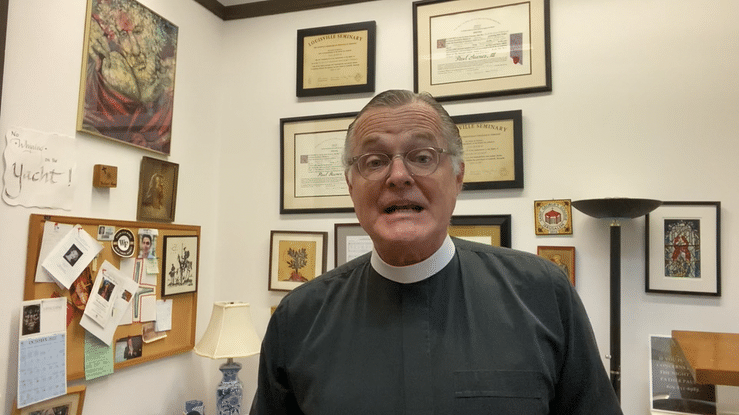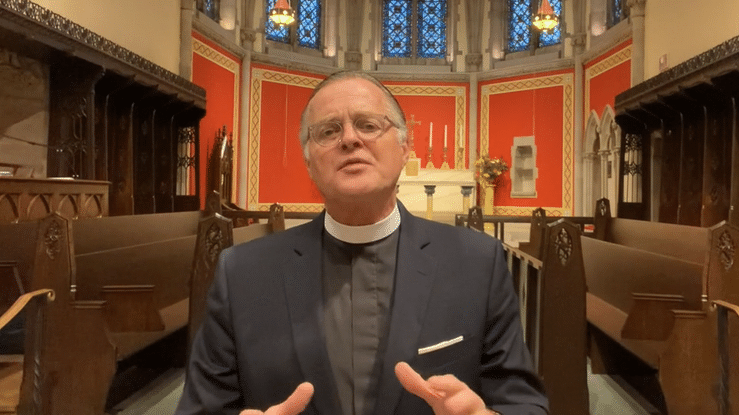Note: This week’s resource corner focuses on the Hebrew Bible text from RCL Track 1 and the Epistle and Gospel texts from both RCL tracks. Typically, we read the RCL Track 2 texts at Trinity on Sundays.
When the people of Israel returned to their ancestral land after the Babylonian Exile, they found the temple in ruins. In the words of the Rev. Dr. Wil Gafney, the people are “disheartened and disenchanted.” As you reflect on this passage, you might dig into the meaning of those two emotions. In this week’s text from Haggai, the prophet (Haggai) reminds the people to “take courage” because the Lord is with them in their work to restore the temple. Even if the temple is not as fancy as it used to be, God is still with the people, just as God was with their ancestors in the “glory days” when the temple was shiny and splendid, and just as God went with the people into exile.
Two books connect well with this lectionary text. The first, Granddaddy’s Turn, by Michael S. Bandy and Eric Stein, is best for younger readers. This book tells the story of the African American struggle for voting rights through the lives of Michael and his grandfather. After waiting for a long time, Granddaddy finally gets a chance to cast his vote in the elections. Michael goes to the ballot box with Granddaddy, but they both experience the bitterness of disappointment when he is turned away without getting a chance to vote. When will justice come? How long must they wait? This issue has recently become contentious again, with pushes for redistricting and increased restrictions on voting throughout the US. As you reflect on this story, you might explore how to advocate for voting rights and justice today.
The second book is better for advanced elementary and middle-grade readers. In Jean DuPrau’s book, City of Ember, the people of Ember are disheartened, much like the Israelites when they return to find their temple in ruins. Built underground, the city of Ember was designed to be the last refuge for humanity. In the past, it was gloriously overflowing with abundant provisions. Now, it is in decay, and the people are struggling to find enough food. The generator which used to power the lights of the city is literally failing. Lina and Doon, two teenagers living in the city, are not ready to give up hope. They team up to find a way out of the failing city. In the final pages, a glimmer of hope appears. This book is the first in a four-part series. As you reflect on the theme of hope in Haggai which connects to both stories, you might discuss what hope looks like in different situations.
In this week’s lectionary text from 2 Thessalonians, Paul exhorts the church in Thessalonica not to trust rumors that Jesus had already returned and that the Day of the Lord had already happened. He writes, “we beg you, brothers and sisters, not to be quickly shaken in mind or alarmed.” This is, of course, easier said than done. In Liz Rosenberg’s story, What James Said, the main character is shaken up when she hears a rumor that her best friend James said she thought she was “perfect.” Now they are in a fight. She doesn’t want to talk to James anymore. It turns out that he actually said that her painting for the art show is “perfect.” What a relief! Have you ever been shaken or alarmed by rumors? How did that feel? If you found out the rumors were not true, how did that new information change your feelings and thoughts? Often, our emotions effect our bodies. Have you noticed how your body responds to different emotion like joy, fear, sadness, contentment, or relief?
In this week’s text from Luke’s gospel, some people test Jesus with a tricky question about the resurrection. They want Jesus to be very specific about what happens after death. This topic still causes many of us to worry. Talking to children about what happens when we die pushes us to think carefully about our own theology (our way of talking about God). Jesus’ answer to his challengers can help us. He says that God is the God of our ancestors and “the God... of the living.” Somehow, the ancestors we think of as dead are still living with God. This is a mystery that shows us the great power and love of our God. Because we know that God loves us so deeply, the way we live now changes. We can be brave in our lives, reaching out in compassion toward others, because we know the depth of God’s love for us, for our neighbors, and for our world. In the wordless book, I Walk with Vanessa, by Kerascoët, a group of children observes one girl (Vanessa) being bullied by another child. They are worried and afraid. The next morning, one of the group shows bravery by knocking on Vanessa’s door and walking with her to school. This act of compassion prompts other children to join them on their walk. With your loved ones, you might share stories of a time when God’s love was reflected in your actions.

























